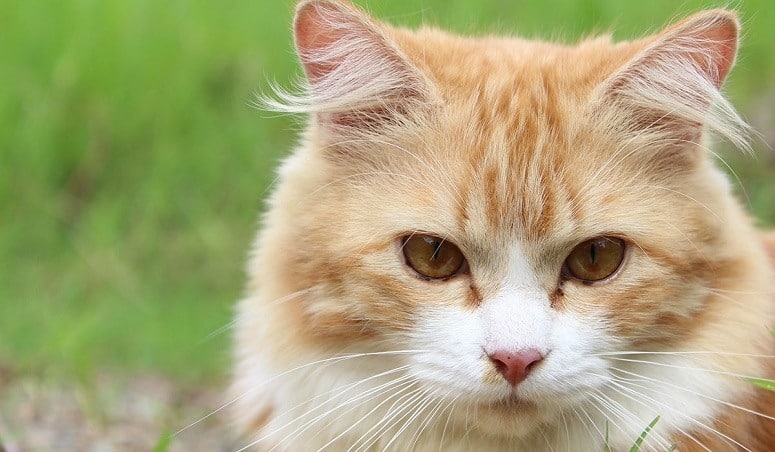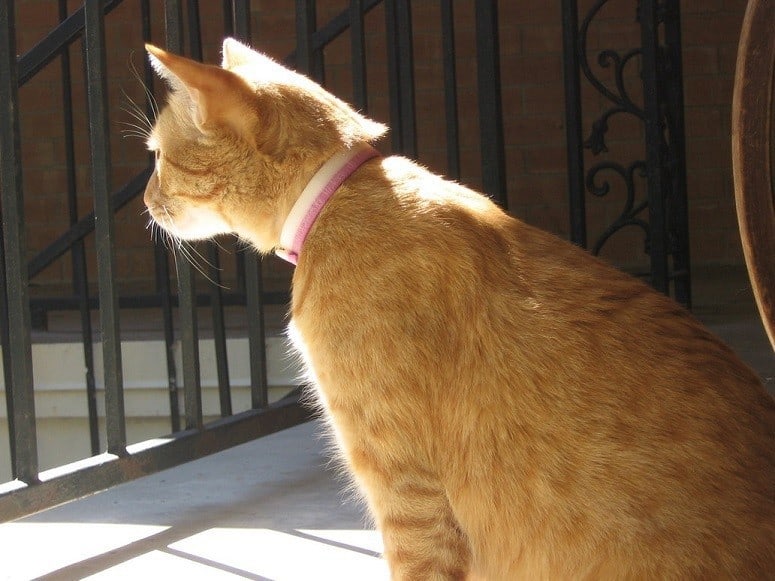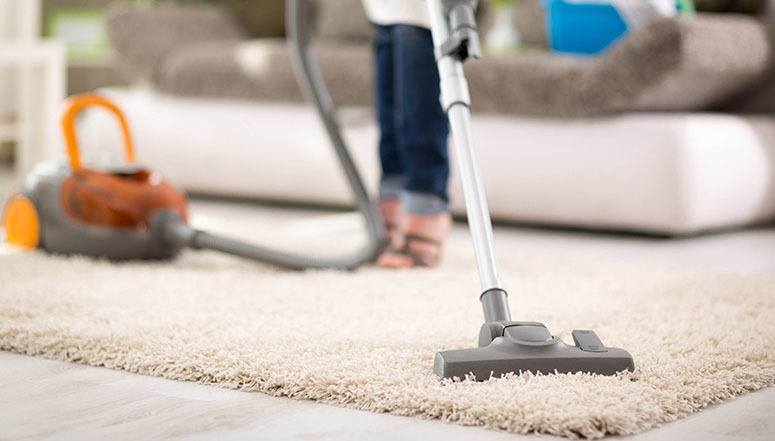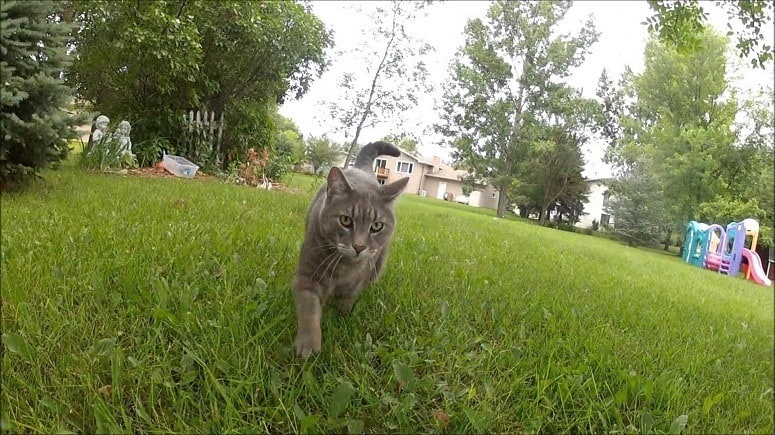If you suspect that your cat may have fleas, there will be a few questions you will want to ask.
During the course of this article, I will try to answer these questions, and by the time you have finished reading, you will be fully equipped and have the upper hand in your (seemingly endless) battle with the cat flea.
I understand that not everyone likes reading huge articles so you can click on each of the questions above to be taken to the relevant section. Jump to the section you need and soon you will know what to do if your cat has fleas.
What Are Fleas?

The cat flea, or Ctenocephalides felis to give its scientific name, is the most common type of flea that is found in domestic cats. Rabbit fleas and hedgehog fleas can also be found on cats, but these types of fleas are much less common.
Fleas infest the skin and fur of cats and they will make your cat very itchy. They can also cause more serious problems, especially if your cat has a flea allergy. They can also give your cat tapeworm and other nasty diseases.
In other words, fleas are bad news for cats.
So what do cat fleas look like?
Adult cat fleas can range in color from reddish-brown to almost completely black. They are about 1-3mm in size, and even though they are roughly the same size as a pinhead they are quite easy to spot.
They are wingless insects that have the ability to jump great distances thanks to their huge back legs. In fact, if a human had the jumping power of a flea, a six-foot man would be able to jump 295 feet long and 160 feet high!
How Do I Know If My Cat Has Fleas?
One of the first signs your cat has fleas is that she will seem irritable and may be scratching a lot. She will probably be grooming herself more than usual to try and eliminate the itchy sensation, mostly around the base of the tail and the legs.

Another sign that you will probably see is in the cat’s bed itself. If she has fleas you can guarantee that there will be evidence in her sleeping quarters. This will be in the form of flea dirt, tiny specks of brownish dirt that may make red spots on the bedding. This is because the flea dirt is dried ingested blood from the fleas.
You have to be especially vigilant with kittens and older cats because a large flea infestation can cause anemia, which is when the red blood cells are much lower than usual, caused by the fleas biting and sucking the cat’s blood. Pale gums and a general tiredness can be signs of anemia.
If you suspect your cat may be suffering from the effects of fleas, the next step is to check her fur and skin.
Take a close look at your cat. If you look very carefully you may actually see the fleas jumping around on her fur. This will be likely if she is heavily infested with fleas, however, in most cases, there will be fewer fleas and they will be more difficult to spot.
The best places to look for fleas on your cat are the hind legs, neck, and tail. Fleas will congregate around these areas, so part the fur and have a good look. Place your cat on something white and comb her fur with a flea comb and check for flea dirt or any adult fleas. If you come across any dirt, put it on a damp paper towel. If it turns red then your cat has fleas somewhere on her body.
How Do I Get Rid Of Fleas On My Cat?
There are a number of different treatments for getting rid of fleas on cats, with some of them more effective than others. Keep in mind that you may have to use some of these methods repeatedly to completely eradicate your cat’s flea problem.
Spot-on Treatments
Spot-on products are the most effective treatment for eliminating fleas from your cat. These products work on two fronts; they kill the fleas living on your cat and they also attack the flea eggs and larvae to prevent them from hatching into fleas.
The spot-on treatment is applied to the back of the neck, this is the best place for it as the back of the neck is one of the few places that your cat’s tongue can’t reach to lick it off.
The treatment travels around your cat’s body with the help of the natural oils in her skin and hair, and within 24 hours it will have reached the entire body of your cat.
The best spot-on treatments contains Fipronil as the active ingredient. Fipronil is fast-acting, and fleas don’t have much of a chance once they come into contact with it. Fipronil attacks the nervous system of fleas and they very quickly become paralyzed and die. The treatment stays on your cat for up to a month so any new fleas that find their way onto her body will come to an abrupt end.
Some more expensive products contain another active ingredient: (S)-methoprene. This attacks any flea eggs and larvae that are on your cat and stops them from hatching.
There is one thing that I must stress: never, ever use a flea treatment that is designed for dogs on your cat. Dog treatments contain stronger ingredients and can be fatal for cats.
Cat Flea Collars

There are two different types of flea collars that you can get for your cat.
The first kind releases a toxic gas that kills or repels fleas. This type of flea collar is usually found in the lower-priced collars, and while they work well in repelling fleas from the area around the collar, they can be pretty ineffective at repelling fleas from other areas of the cat’s body.
The second, and more effective type of flea collars work by sending a released substance into the cat’s skin, and this substance then travels along the whole body of the cat. These flea collars are more expensive, but the results are definitely worth the extra cost.
If you do buy a flea collar for your cat, ensure that it has a safety release catch or elasticated ends to prevent the kitty from getting choked if the collar gets caught on a tree branch.
Flea Powders
Flea powders used to be used before the creation of spot-on treatments. They take longer to work and are only effective when the powder is in contact with your cat. So if you apply the powder and then your cat goes out in the rain, the powder will be washed off. Some powders contain toxins that can be poisonous to fish and small animals.
I do not recommend the use of flea powders on cats; there are much safer and effective products available these days.
Flea Sprays
Flea sprays fall into the same category as flea powders. They are not as effective as more modern treatments and can cause harm to your cat and the environment.
Again, I do not recommend the use of flea sprays on cats; there are much safer and effective products available these days.
Flea sprays that are used to control fleas in the house can be used; I will discuss these later in the article.
Injections
There are flea injections that can be given at the vet. Program is a popular one and these treatments can last up to six months. The active ingredient in the Program is lufenuron, however, this only prevents flea eggs from hatching into fleas, and it does not kill the living adult fleas.
Because of this, other treatments will need to be administered to your cat to effectively remove fleas.
How Do I Get Rid Of Fleas In My House?
Just because you have gotten rid of the fleas on your cat, does not mean that they won’t come back. If your house is infested with flea eggs and larvae, as soon as the topical treatments stop being effective on your cat she will quickly become infested again.
It is just as important to eradicate the fleas from your home as well as your cat.
Wash You And Your Cat’s Bedding
The first stage of flea extinction is to wash everything that can be washed. This includes cat bedding, your bedding, rugs, towels, and clothes, anything that your cat has been in contact with. Don’t forget that fleas can live on humans too so be sure to wash your bedding also.
If there are signs of a heavy flea infestation in your house, it might be wise to dispose of any bedding or clothing that your cat has been in contact with. The effort required to completely remove all signs of fleas from fabric is sometimes just too great.
Read more on how to remove pet dander from your home .
.
Become Best Friends With The Vacuum
The vacuum should become your best friend. Vacuum at least twice a day or more if you can, as much as it takes to get all those flea eggs and larvae off of the carpets. The vibrations from the vacuum cause the fleas to come to the surface of the carpets and bedding.

Flea eggs can hatch any time from two days to two weeks, so the quicker they are removed the better. You need a decent vacuum cleaner that is designed with pets in mind and that is capable of picking up fleas as well as their eggs.
One mistake that a lot of people make is to vacuum regularly, but not empty the vacuum. Flea eggs can, and will, hatch inside the vacuum, and then the fleas will escape back into your house.
It is crucial to empty the vacuum, and put the contents outside of the house, after every use.
Invest In A Good Flea Spray
Once you have washed everything that you can possibly wash, and hoovered everywhere in your house, it’s time to get a flea spray.
A good flea spray, like Indorex flea spray, contains Permethrin as the active ingredient which kills adult fleas. It also contains Pyriproxyfen which is used to control the growth of flea eggs and larvae.
Is Permethrin Safe For Cats?
You may have heard that Permethrin, the active ingredient in Indorex and most flea sprays, is toxic for cats. This is correct and the high dose of Permethrin that is found in spot-on treatments for dogs can be fatal for cats. However, flea sprays contain lower doses of Permethrin and these levels are completely safe for cats.
It is important to understand that household flea sprays are to be used around the house and not to be sprayed directly onto the cat.
The flea spray should be used on carpets and other soft furnishings, and one dose can last up to six months.
How To Treat Outside The House
If your cat spends a lot of her time outside, you will need to give the garden some flea treatment. It’s more difficult to treat the outdoors than it is indoors, especially if you have a large space outside.

The first thing to do is to keep the grass short. Fleas love hiding in long grass and it also retains more moisture, which fleas love. The next stage is to flood the garden. Use a hose or pour buckets of water over the grass until it is saturated. This will kill any flea eggs and larvae that are in the grass.
Once the garden has dried out, then you can apply an outdoor flea spray. These stay effective for up to six months and will take care of any missed eggs. Always check the label of any product and ensure it is suitable for cats.
How Can I Prevent My Cat From Getting Fleas In The First Place?
When all is said and done, the most effective cure for fleas is prevention. If you keep up to date with your cat’s spot-on treatments, use cat flea collars, and keep your cat’s surroundings generally clean you should limit the number of flea infestations that occur.
However, in all honesty, you will at some point have to deal with fleas in your home. If you follow the steps in this article you will give yourself a better chance of eliminating the fleas for good.
If you find that the fleas keep reappearing, don’t worry. It can be very frustrating to put in all this work and see no benefits, but the only thing you can do is keep trying. Go through all the steps again and eventually you will win your battle with the fleas.
Declutter your home once and for all (Even if you have no time and don't know where to begin)! Learn More.

